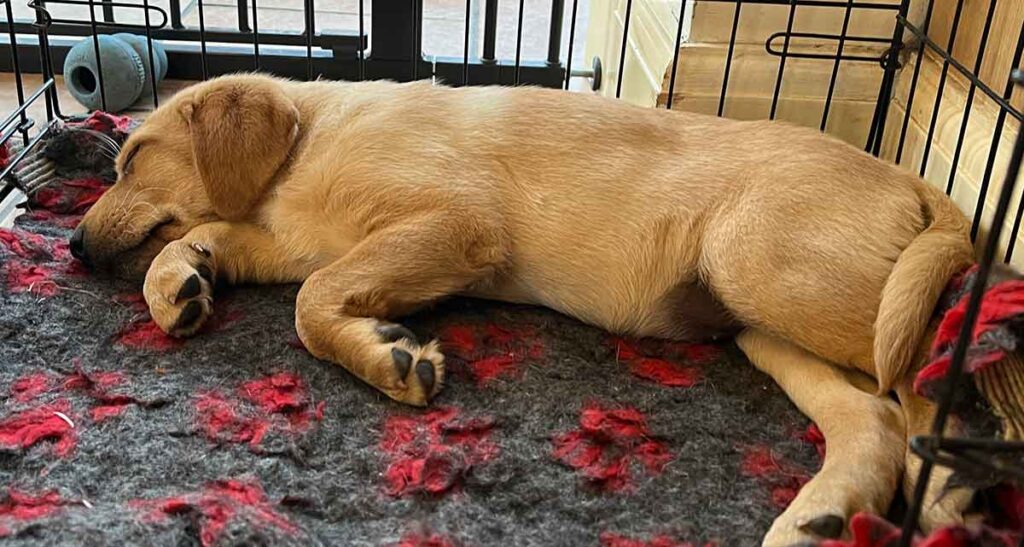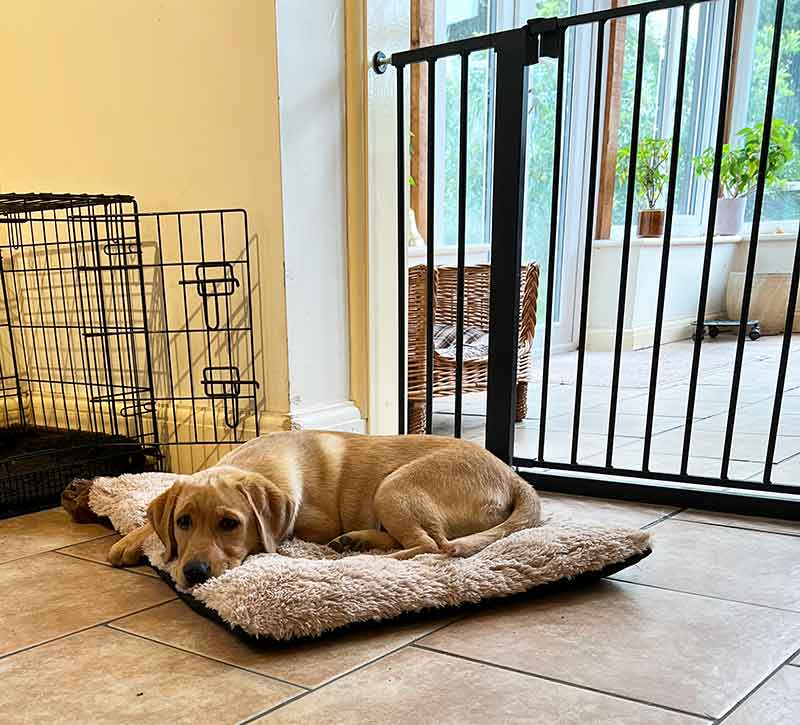I recently had a setback with my youngest Labrador Bonnie. She dismantled one of my favorite dog beds when I thought she was long past that stage! I’ll talk about how this happened, and give you some tips to help you avoid the same situation, and other more common causes of destructive chewing.

All puppies will chew on their bedding, and most puppy parents expect this. Some are surprised by the destructive power of those tiny teeth, and a proportion of puppies are serious bed eaters! That’s why I always recommend you hold off on buying the latest stylish, padded luxury cushions, until you get to know your puppy a bit.
Adult dogs chew their beds too, and this can be a lot more problematic, especially when bed chewing restarts at a point in your dog’s life when you thought you were done with all that!
Dog beds and cushions can be expensive. It’s easy to part ways with the best part of $100 for a really nice padded mattress with a spare cover. So chewing, when it happens, is a big deal.
Can you train a dog never to chew their bed?
I think it’s important to recognize that you cannot teach a dog not to chew in your absence. Punishment when you come back after leaving a dog alone, won’t work because the dog cannot associate the punishment with the crime.
And that guilty face as your dog greets you with a bunch of cushion stuffing hanging out of their mouth? That’s anxiety I’m afraid. Either because you look angry, or sound upset.
For those reasons, protecting the investment you made in your dog’s bed is much more about management, prevention, and building good habits, than it is about training.
Reducing the chance of chewing
I want to be clear at the start, I cannot give you a foolproof solution to a dog that chews up their bedding. What I can do, is give you multiple ways to reduce chewing, and in many cases break the chewing habit completely.
And we’ll also look at ways to manage a dog so that chewing, generally, becomes a less expensive problem, and eventually not much of a problem at all.
I live with Labradors which often carry on chewing (sometimes sporadically) up to around their second birthday. So I’ve used all these approaches over the years, and it’s often necessary to use several approaches combined.
- Age appropriate bedding
- Introducing new bedding carefully
- Sprays
- Tougher fabrics
- Providing the right chew toys
- Gated areas in your home
People often ask me where I get the things I buy for my dogs so there are some links below. Some of them are affiliate links and you should know that if you make a purchase after clicking on those, Dogsnet will receive a small commission which does not affect the price you pay.
Age appropriate bedding
It’s important to buy bedding that suits the age and developmental stage of your dog. I usually hold off buying padded bedding until a puppy is around a year old. This age isn’t set in stone as each dog is different. With Labs it may be a little older.
Up to that point, the type of bedding least likely to be destroyed is vetbed fleecePaid Link. I always have some of this put by. I line crates and baskets with it, and raise all my puppies on it. It goes in the washing machine and tumble dryer and gets softer and more flexible with age.
I don’t know for certain why most puppies don’t dismantle vetbed, except that many puppies are whelped on it. Which brings me to my next point.
Introducing new bedding
Dogs are far more likely to chew a bed, blanket or cushion that is brand new, or at least new to them.
Anything that smells new and different attracts a dog’s attention. And it’s easy for a sniff and a lick to turn into a nibble. Then before you know it, there’s a loose bit of fabric and the stuffing is exposed. And who wouldn’t be tempted to pull that out!
So my simple tip for that is always to have a piece of old blanket or vetbed fleece in the bottom of your dog’s basket, underneath any padded cushion. When you buy a new cushion, simply place the old blanket over the top and tuck it in.
Keep replacing the old blanket every time the dog pulls it off until they lose interest in what’s underneath, and the new bed has absorbed the smell of the old one.
This usually only takes three or four days. At that point you can fold the old blanket back under your nice new bed and all should be well.
Anti Chew Sprays
You can buy a range of anti chew sprays that you squirt on furniture. They work because many dogs find the taste pretty horrible. How successful you will be with sprays depends on your dog and on the type of dog bed you are using.
I’ve tried various different sprays over the years to reduce nibbling on chair legs, and wicker dog baskets. Bitter apple spraysPaid Link seem to work the best. These have worked well to deter my young Lab Bonnie from her tendency to nibble the corners of wicker baskets. But there are some dogs that seem completely unaffected by any of them.
In general, sprays are more suitable for solid items than for fabrics. And with fabrics, your best defence initially is to buy chew resistant beds and to make sure that young dogs still have access to soft toys in case they need to continue chewing fabric of some kind. Let’s look at tough fabrics first.
Tougher fabrics
The downside of tough fabrics, is that they are less cuddly. And the stiffness of them means that they may look less attractive than you had hoped.
I doubt that any fabric dog bed currently on the market is entirely chew proof, but some are pretty tough. The really tough ones are usually waterproof and pretty easy to wipe and wash too.
They can be especially useful in utility areas of your home that are not in full view of your guests, and in areas where you are not so bothered about decor.
I have a P&L heavy duty dog mattress, similar to this onePaid Link, in an old wicker basket in our hall. It is made from very tough polyester fabric that looks like canvas. And none of my dogs has ever made a dent in it!. If they made it in an oval shape I’d have more of them.
Look for waterproof beds made from Oxford Fabric if this is the sort of bed that appeals to you.
Providing the right chew toys
Young dogs (and some older ones) need to chew. This really is a need, rather than a ‘want’. Many dogs need to chew on different textures. That means their rubber chew toy is not going to meet all their chewing needs.
You need to provide something hard to chew, I use tree root chews. And something soft to chew that won’t disintegrate in two minutes. So that your dog has a choice of textures.
It can be difficult to introduce soft toys to an older dog, as without prior experience, and if the toy is new to them, destruction of the toy is much more likely. Even so, it’s worth a try. The Kong Knots rangePaid Link is good and has minimal stuffing.

Giving your dog a range of appropriate chew toys will reduce the risk of bed chewing. But it won’t eliminate it entirely. That’s where supervision and prevention comes in.
Buying a new toy along with the bed is a good idea. If you have recently given your dog a new bed watch them carefully when you introduce it to them. If they show a lot of interest in it, start nibbling at corners, or start digging or scraping at it, bring out the new toy with a flourish and encourage them to play with that instead. And don’t forget to tuck that old blanket in over the new bed until it smells less new.
Gated areas in your home
If you have a part of your home that’s really special to you. Where you like everything to look just so. And where you have invested in some lovely dog beds that match your decor, then you need to think about supervising your young dog in those areas
A technique we use that has worked well for our family, is to gate off our living area, where it joins the kitchen, so that young dogs don’t have access to the soft furnishings there except when they join us under supervision in the evenings.

We use extra wide baby gatesPaid Link for this purpose, ours are Babydan, but there are lots of good brands. Just make sure you get pressure mounted if you don’t want to have to drill into your walls. We take them down when our puppies are around a year old. Except that for some puppies, this is a bit too soon.
With Bonnie, she was not quite ready to have access to the more expensive dog beds in this half of the house when we took down the gates. I rushed a bit because I was tired of having to step over them or open and close them all the time.
And the result was an expensive pile of fabric and stuffing all over the floor. We should have either swapped out the beds for some cheaper ones for a few months, or left the gates up for a while longer.
What has prevented a recurrence of the problem is a combination of things. Returning some of the soft toys we had put away, buying her a new tree root chew, and taking her with me (or shutting her out of that room) when I was outside doing farm chores, or upstairs on my treadmill desk.
If I were not around at home so much I would probably have put the gates back for a few months instead.
Less and more than you think
Many people hope that they can train or even punish a dog out of chewing their bedding. And that’s why I said there may be less you can do than you might think. Because training isn’t really the answer here, and punishment just doesn’t work.
On the other hand there’s a lot more you can do than most people realise. From using toys to redirect dogs that are showing too much of an interest in their new bed, to gating off your best beds, to protecting that new bed with old fabric for a while.
I hope you find some of the tips above helpful. And if after all that, you think your young dog is not quite ready to treat their new bed with respect, why not just pop it away in a closet for a while and try again in a few weeks time.

Free Training Tips
Get Pippa's free dog training tips delivered to your inbox

 This Is Why Your Dog Doesn’t Listen (And How To Fix That!)
This Is Why Your Dog Doesn’t Listen (And How To Fix That!)
Thank you Pippa, your hints are so useful, although fingers crossed and touching wood to date this has not been much of a problem with our little 6month old Sprocker girl. She has pulled part of the soft base of her living room playpen from the frame and can now escape to the wonderful world of mischief in said room if not watched carefully!! Mind you the fabric is extremely flimsy
Sounds like you have a little escape artist there! Thank you for your kind words – I’ve passed them on to Pippa 🙂